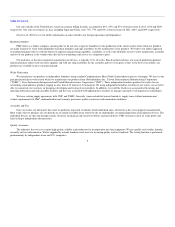Adaptec 2011 Annual Report Download - page 18
Download and view the complete annual report
Please find page 18 of the 2011 Adaptec annual report below. You can navigate through the pages in the report by either clicking on the pages listed below, or by using the keyword search tool below to find specific information within the annual report.
Table of Contents
buy our products. This could materially and adversely affect our ability to retain existing customers or attract new customers. In addition, these defects or
bugs could interrupt or delay sales to our customers.
We may have to invest significant capital and other resources to alleviate problems with our products. If any of these problems are not found until after
we have commenced commercial production of a new product, we may be required to incur additional development costs and product recall, repair or
replacement costs. These problems may also result in claims against us by our customers or others. In addition, these problems may divert our technical and
other resources from other development efforts. Moreover, we would likely lose or experience a delay in, market acceptance of the affected product or
products, and we could lose credibility with our current and prospective customers.
Industry consolidation may lead to increased competition and may harm our operating results.
There has been a trend toward industry consolidation in our markets for several years. We expect this trend to continue as companies attempt to
improve the leverage of growing research and development costs, strengthen or hold their market positions in an evolving industry and as companies are
acquired or are unable to continue operations. Companies that are strategic alliance partners in some areas of our business may acquire or form alliances with
our competitors, thereby reducing their business with us. We believe that industry consolidation may result in stronger competitors that are better able to
compete as sole-source vendors for customers. This could lead to more variability in our operating results and could have a material adverse effect on our
business, operating results and financial condition.
Our business may be adversely affected if our customers or suppliers cannot obtain sufficient supplies of other components needed in their product
offerings to meet their production projections and target quantities.
Some of our products are used by customers in conjunction with a number of other components, such as transceivers, microcontrollers and digital signal
processors. If, for any reason, our customers experience a shortage of any component, their ability to produce the forecasted quantity of their product offerings
may be affected adversely and our product sales would decline until the shortage is remedied. Such a situation could harm our operating results, cash flow and
financial condition.
We rely on limited sources of wafer fabrication, the loss of which could delay and limit our product shipments.
We do not own or operate a wafer fabrication facility. In fiscal 2011, three outside wafer foundries supplied more than 95% of our semiconductor wafer
requirements. Our wafer foundry suppliers also make products for other companies and some make products for themselves, thus we may not have access to
adequate capacity or certain process technologies. We also have less control over delivery schedules, manufacturing yields and costs than competitors with
their own fabrication facilities. If the wafer foundries we use are unable or unwilling to manufacture our products in required volumes, or at specified times,
we may have to identify and qualify acceptable additional or alternative foundries. This qualification process could take six months or longer. We may not
find sufficient capacity quickly enough or at an acceptable cost, to satisfy our production requirements.
Some companies that supply our customers are similarly dependent on a limited number of suppliers to produce their products. These other companies'
products may be designed into the same networking equipment into which our products are designed. Our order levels could be reduced materially if these
companies are unable to access sufficient production capacity to produce in volumes demanded by our customers because our customers may be forced to
slow down or halt production on the equipment into which our products are designed.
17
























